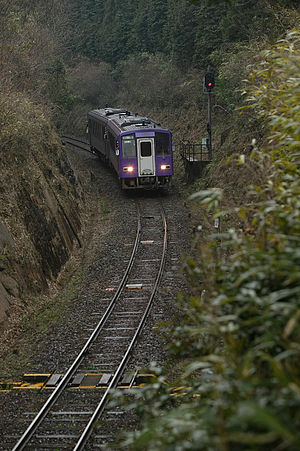Kansai Main Line
| Kansai Main Line | |
|---|---|
| V | |

KiHa 120 diesel car on a rural section
|
|
| Overview | |
| Type | Heavy rail |
| Locale |
Aichi Prefecture Mie Prefecture Kyoto Prefecture Nara Prefecture Osaka Prefecture |
| Termini | Nagoya JR Namba |
| Stations | 52 |
| Operation | |
| Opened | 1889 |
| Owner |
JR Central JR West |
| Technical | |
| Line length | 179.6 km (111.6 mi) |
| Track gauge | 1,067 mm (3 ft 6 in) |
| Electrification | 1,500 V DC, overhead line (Nagoya–Kameyama, Kamo–JR Namba) |
| Operating speed | 120 km/h (75 mph) (Nagoya–Kawarada, Nara–Tennoji) 95 km/h (59 mph) (Kawarada–Nara, Tennoji–JR Namba) |
The Kansai Main Line (関西本線 Kansai-honsen?, also called the "Kansai Line") is a railway line in Japan, which connects Nagoya Station with JR Namba Station in Osaka. It is jointly run by the Central Japan Railway Company (JR Central) and West Japan Railway Company (JR West), with the boundary between both companies being located at Kameyama Station in Kameyama, Mie.
The section from Kamo Station west to JR Namba Station is electrified and a part of the JR West "Urban Network", and is nicknamed the Yamatoji Line. The JR Central section from Nagoya to Kameyama is also electrified.
Despite its name, for much of its length it is a very local line with mainly single track sections and no regular express services. The line was originally built in the 1890s by Kansai Railway (later under the Japanese Government Railways and Japanese National Railways) as an alternate route from south Osaka to Nara and Nagoya, but competition from the Kintetsu lines and declining ridership forced the line to become two commuter lines to Osaka and Nagoya respectively, with a less-used section in the middle.
Formerly a Kasuga limited express train went the whole of the Kansai Main Line, but this service was discontinued in March 2006.
The Osaka Railway Co. opened the Minato-Machi (now Namba) - Nara section between 1889 and 1892. The company merged with the Kansai Railway Co. in 1900.
...
Wikipedia
